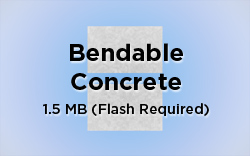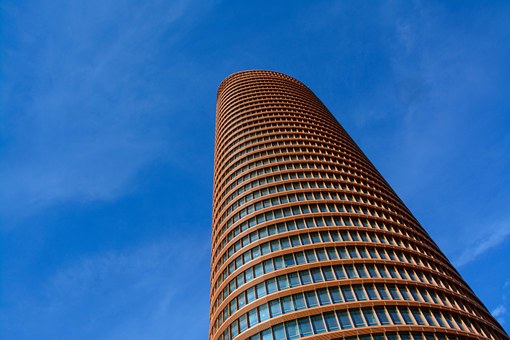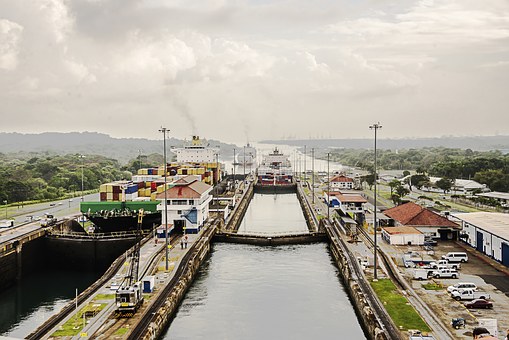Concrete cracks for many reasons: thermal expansion or contraction, applied loads, and even earthquakes can fracture the concrete in roads, structures, and more. In particular, cracks in load-bearing elements, like concrete columns and beams, have the potential to create serious instability problems. To avoid expensive repairs—or even reconstruction—of compromised structures, engineers have worked to design self-repairing concrete that can regain its stiffness after being cracked and will remain capable of bearing weight.
Introduction
Concrete is arguably the world’s most important building material today. Each year, twice as much concrete is used in construction projects as all other building materials combined [1]. Concrete’s role today is often in foundations for homes and in paved roads, but engineers have historically used concrete for spectacular structures like the Hoover Dam, the Roman Colosseum, and the Panama Canal. Engineers have also sought to enhance the properties of concrete by making it resistant to weather, improving its appearance, and identifying the best balance between its weight and its strength. Today, they look to address one of concrete’s worst flaws: cracking.
Concrete Logic
Concrete is a solid composite made primarily of aggregate (granular elements like sand or gravel), cement, and water. However, not all concrete is the same. Different ratios of these ingredients will yield concrete with different properties, which is especially important when designing concrete with a specific function. For example, concrete sidewalks must be strong enough to support a wide spectrum of weights, from morning joggers to U-Haul trucks backing into driveways. Since sidewalks are so abundant and widespread, it is important for their construction and maintenance to be as inexpensive as possible. The same general design process takes place when engineers design concrete beams, columns, bridges, or walls. Although each type of concrete has its particular advantages, all concrete is liable to crack, and engineers must also address this risk when planning construction projects.
Cracks
The two most common forces that cause concrete to crack are extreme compression and extreme tension. These can also be understood as pushing and pulling forces, respectively. Concrete is known for its very high compressive strength, but it has rather weak tensile strength: concrete’s typical tensile strength is somewhere in the range of 10%-15% of its compressive strength [2]. When forces within the concrete exceed the strength of the chemically bonded material, a crack will form. Because concrete’s tensile strength is low relative to its compressive strength, tension is more likely to be the force in excess. Thermal expansion or contraction, stretching loads, or natural events like earthquakes are all reasons why concrete could experience excess tension [1]. While limiting these external factors is one method for preventing cracking, engineers have also realized that increasing the overall tensile strength of the concrete may be a better solution. This led to the development of Engineered Cementitious Composite (ECC), or bendable concrete.
The First Step
ECC was specifically developed to yield a higher tensile strength than conventional concrete. This composite material is similar to concrete but contains small microfibers throughout its structure [3]. These fibers behave like string or a bungee cord. If you attach a ball to each end of a bungee cord and try to bring the balls together, there is essentially no resistance. If you take the two balls and try to separate them as far as you can, past the original length of the cord, the cord tries to draw them back together. The fibers in ECC work the same way. Concrete already has high compressive strength, but in the bungee cord example, it is not very good at preventing the balls from pulling away from one another. Bringing the ECC fibers into the picture, however, increases concrete’s tensile strength [3].
Additionally, greater tensile strength also means the concrete is more ductile. A material’s ductility reflects its ability to bend or bow without being permanently deformed [4]. Rubber, for example, is a highly ductile material, while glass and conventional concrete have minimal ductility. One way to indirectly measure ductility is by determining a material’s strain capacity. Strain is the change in length of the material (when stress is applied) divided by its original length (when no stress is applied). Typical concrete has a strain capacity of about 0.1%, while ECC has a much larger strain capacity in the range of 3-7% [4]. This means that a 100-foot-long slab of ECC can stretch anywhere from 3 to 7 additional feet before permanent deformation occurs. Normal concrete, on the other hand, can only stretch 0.1 feet before cracking.
Self-Healing ECC
Another key attribute of ECC is its ability to control crack width. This composite was originally developed by University of Michigan’s Professor Victor Li in 1993—Li’s first step towards developing self-healing concrete [2][3][5].
By minimizing the width of cracks, damaged concrete can be repaired—or repair itself—much more easily. By adding an ingredient to the ECC mix that is reactive with water and the carbon dioxide in air, “new” concrete (calcium carbonate) can form to fill these cracks [6]. Twenty-eight days after the concrete was exposed to rain, it almost completely healed. Lab results have indicated that depending on the crack size, the concrete may have to experience several episodes of rain for new material to fill the cracks. [6]
This approach is especially promising for concrete roads and other structural elements that are exposed to the elements: in this way, concrete can “heal” without any direct human intervention. The idea that concrete can be repaired by rain still remains a novelty, but research indicates that application of this technology in the field is indeed feasible. Lab tests have shown that cracks less than 15 centimeters wide can “heal” completely with the addition of water while maintaining 100% strength [4]. Furthermore, cracks can be repaired regardless of the direction in which they propagate, while conventional repair methods are limited to specific orientations. However, ECC can cost about two or three times more than normal concrete, a factor that limits its application in the field for the time being [5].
ECC in a Declining Infrastructure
In a 2009 report, the American Society of Civil Engineers (ASCE) gave the U.S. infrastructure a grade of “D” due mainly to delayed maintenance [2]. This issue may not be so surprising when one understands the size and growth of America’s infrastructure. Currently, there are over four million miles of road in the United States, 2.8 million miles of which are paved. According to the American Road and Transportation Builders Association, between 2000 and 2010 the U.S. built an average of 13,085 miles of road per year, and by the end of 2010, paved roads covered a total of 17,879 square miles of land [7]. In light of these facts, it is estimated that in order to receive a grade of “B” by ASCE, the U.S. will need to spend 2.2 trillion dollars over the next five years in road maintenance and repair [2]. Having self-healing concrete may solve the issue of high maintenance costs by reducing the human resources required for the job. ECC’s high material cost concerns many engineers and contractors, but reducing maintenance costs over the concrete’s lifetime could offset its initial cost [5].
Conclusion
The cracks in concrete cause a variety of complications, but by using something as simple as rainwater, engineers have developed a material can address its own damage. Although some are skeptical about the idea of using ECC in the field, others believe the long-term benefits will outweigh the initial costs. Its ductility and its ability to control the width of cracks both make ECC a promising candidate for the future of self-healing concrete. With the amount of research conducted on this material around the globe, it is safe to say there is a bright future for this self-maintaining material. Given its recent success and popularity in the research community, self-healing ECC may compose interstates, city streets, and major structures all over the world.




